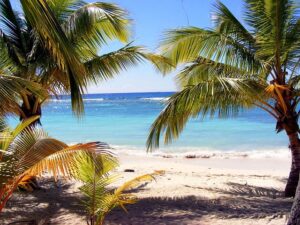A Secret Garden to discover before the cruise ships do

Dominica, a remote Caribbean island, enchants with its waterfalls, hot springs and hummingbirds. But a new airport and more tourists could tame its wildness.
The hiking trail to Middleham Falls on the Caribbean island of Dominica is all wet leaves, slippery black stones and steps formed by tree roots. It could be a path in Middle-earth, shrouded, shadowy and green, fit for hobbits and fairies. Where sunlight pierced the canopy, rainbows formed in the mist, almost close enough to poke. Here and there, hummingbirds drew nectar from huge blossoms.
The goal on that January day: a 200-foot forest cascade filling and refilling little pools on the valley floor, where I could — as one does in the secret hot pools and isolated waterfalls of Dominica — shed my clothes, slip into water and commune with the hummingbirds like a fairy queen.
Dominica, 29 miles long and, at its widest, 16 miles across, is one of the wildest Caribbean islands. A former British colony, it lies in the eastern Caribbean between Guadeloupe and Martinique. Many travelers base themselves in its capital, Roseau. Thanks in part to its rugged topography, bisected by a volcanic mountain range with Jurassic-looking conical peaks, the island was the last Caribbean island to be colonized by Europeans.
Even today, getting to, and around, this tropical bastion, a New York Times 52 Places to Go in 2024 pick, takes a taste for adventure, patience and a strong stomach. There are few direct flights from the United States and once one lands, the journey is not over. Driving around the island in a rental car — to lodging, hikes and snorkeling sites, and to visit local experts — usually involved long, queasy rides on narrow concrete ribbons hacked through mountain jungle in the last century by pickax, shovel and wheelbarrow.
Read more: https://www.nytimes.com/2024/02/27/travel/dominica-caribbean-island.html

MORE NEWS










